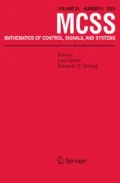Abstract
This article deals with the approximation of the boundary controls of a 1-D linear equation modeling the transversal vibrations of a hinged beam using a finite-difference space semi-discrete scheme. Due to the high frequency numerical spurious oscillations, the semi-discrete model is not uniformly controllable with respect to the mesh size and the convergence of the approximate controls corresponding to initial data in the finite energy space cannot be guaranteed. In this paper we analyze how do the initial data to be controlled and their discretization affect the result of the approximation process. We prove that the convergence of the scheme is ensured if the continuous initial data are sufficiently regular or if the highest frequencies of their discretization have been filtered out. In both cases, the minimal weighted \(L^2\)-norm discrete controls are shown to be convergent to the corresponding continuous one when the mesh size tends to zero.






Similar content being viewed by others
References
Avdonin SA, Ivanov SA (1995) Families of exponentials. The method of moments in controllability problems for distributed parameter systems. Cambridge University Press, Cambridge
Ball JM, Slemrod M (1979) Nonharmonic fourier series and the stabilization of distributed semi-linear control systems. Commun Pure Appl Math XXXII:555–587
Carthel C, Glowinski R, Lions J-L (1994) On exact and approximate boundary controllability for the heat equation: a numerical approach. JOTA 82:429–484
Coron JM (2007) Control and nonlinearity, vol 136 of Mathematical surveys and monographs. American Mathematical Society, Providence
Ervedoza S (2009) Spectral conditions for admissibility and observability of wave systems: applications to finite element schemes. Numer Math 113:377–415
Ervedoza S, Zuazua E (2010) A systematic method for building smooth controls for smooth data. Discrete Contin Dyn Syst Ser B 14:1375–1401
Ervedoza S, Zuazua E (2009) Uniformly exponentially stable approximations for a class of damped systems. J Math Pures Appl 91:20–48
Glowinski R, Lions JL (1995) Exact and approximate controllability for distributed parameter systems. Acta Numer 4:159–328
Haraux A (1989) Une remarque sur la stabilisation de certains systemes du deuxieme ordre en temps. Port Math 46:245–258
Hughes TJR (1987) The finite element method. Prentice Hall Inc., Englewood Cliffs
Infante JA, Zuazua E (1999) Boundary observability for the space semi-discretization of the 1-D wave equation. M2AN 33(2):407–438
Ingham AE (1936) Some trigonometric inequalities with applications to the theory of series. Math Zeits 41:367–379
Isaakson E, Keller HB (1996) Analysis of numerical methods. Wiley, New York
Jafard S, Micu S (2001) Estimates of the constants in generalized Ingham’s inequality and applications to the control of the wave equation. Asymptot Anal 28:181–214
Kahane J-P (1962) Pseudo-périodicité et séries de Fourier lacunaires. Ann Scient Éc. Norm Sup 79:93–150
Komornik V, Loreti P (2005) Fourier series in control theory. Springer-Verlag, New York
Leon L, Zuazua E (2002) Boundary controllability of the finite-difference space semi-discretizations of the beam equation. ESAIM Control Optim. Calc. Var. A Tribute to J.-L. Lions, Tome 2:827–862
Lions J-L (1988) Controlabilité exacte, stabilisation et perturbations des systèmes distribués, vol 1. Masson, Paris
Lunardi A (2009) Interpolation theory. Lecture Notes Scuola Normale Superiore di Pisa (New Series). Edizioni della Normale, Pisa
Micu S (2002) Uniform boundary controllability of a semi-discrete 1-D wave equation. Numer Math 91:723–768
Micu S, Zuazua EE (2005) An introduction to the controllability of partial differential equations. In: Sari T (ed) Quelques questions de theorie du controle. Collection Travaux en Cours Hermann, Hermann
Miller L (2012) Resolvent conditions for the control of unitary groups and their approximations. J Spectr Theory 2:1–55
Miller L (2004) How violent are fast controls for Schrödinger and plate vibrations? Arch Ration Mech Anal 172:429–456
Seidman T, Yong J (1996) How violent are fast controls? Math Control Signals Syst 9:327–340
Tenenbaum G, Tucsnak M (2007) New blow-up rates for fast controls of Schrödinger and heat equations. J Differ Equ 243:70–100
Tucsnak M, Weiss G (2009) Observation and control for operator semigroups. Birkhäuser advanced texts. Springer, Basel
Vichnevetsky R, Bowles JB (1982) Fourier analysis of numerical approximations of hyperbolic equations, vol 5. SIAM Studies in Applied Mathematics, Philadelphia
Young RM (1980) An introduction to nonharmonic fourier series. Academic Press, New York
Zuazua E (2005) Propagation, observation, and control of waves approximated by finite difference methods. SIAM Rev 47:197–243
Acknowledgments
The first author was partially supported by Grant PN-II-ID-PCE-2011-3-0257 of the Romanian National Authority for Scientific Research, CNCS UEFISCDI and by Grant MTM2011-29306 funded by MICINN (Spain). The second and the third authors were partially supported by Grant PN-II-ID-PCE-2011-3-0257 of the Romanian National Authority for Scientific Research, CNCS UEFISCDI. The authors wish to thank the anonymous referees for their interesting and constructive suggestions which have greatly improved the first version of this paper.
Author information
Authors and Affiliations
Corresponding author
Rights and permissions
About this article
Cite this article
Micu, S., Rovenţa, I. & Temereancă, L.E. Approximation of the controls for the linear beam equation. Math. Control Signals Syst. 28, 12 (2016). https://doi.org/10.1007/s00498-016-0161-x
Received:
Accepted:
Published:
DOI: https://doi.org/10.1007/s00498-016-0161-x
Keywords
- Beam equation
- Boundary control approximation
- HUM controls
- Filtering
- Regularity
- Moment problem
- Biorthogonals




